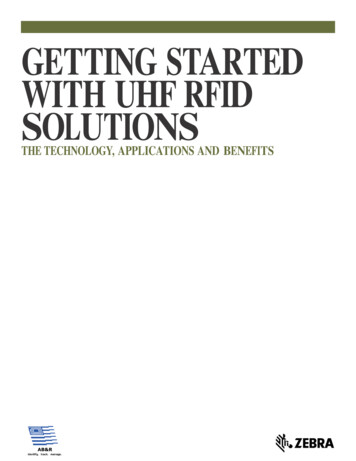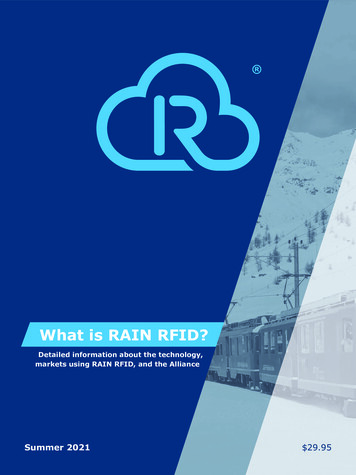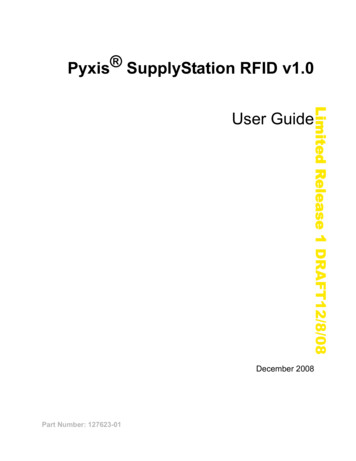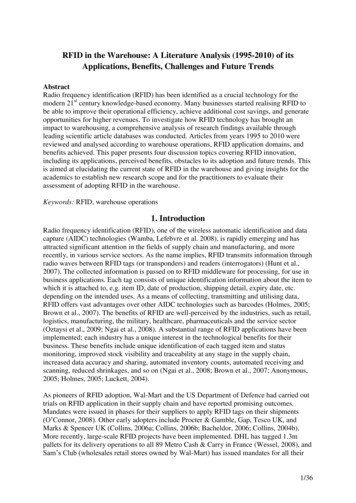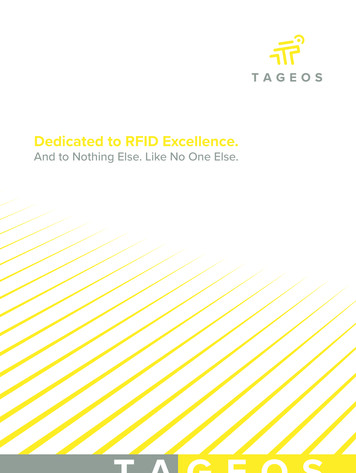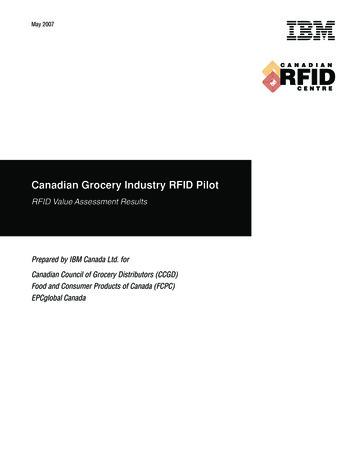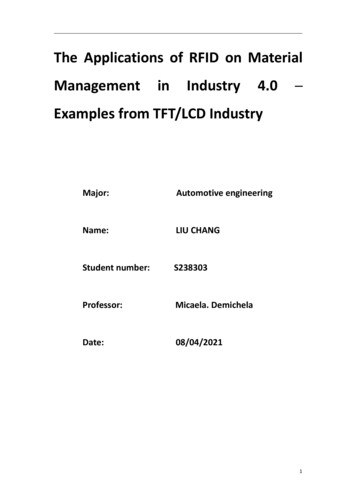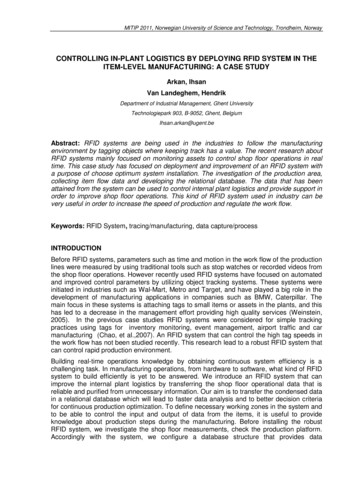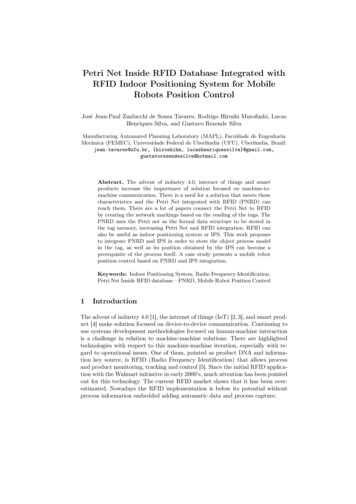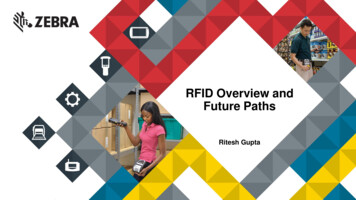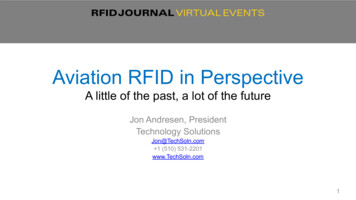
Transcription
Aviation RFID in PerspectiveA little of the past, a lot of the futureJon Andresen, PresidentTechnology SolutionsJon@TechSoln.com 1 (510) 531-2201www.TechSoln.com1
Industry Credentials 17 years at United Airlines TechOps20 years consulting in aviationPrimary architect and author of ATA Spec2000 Chapter 9 standards––––Barcode part markingRFID part markingCradle-to-Grave TraceabilityBarcode/RFID shipping label standard2
What Problem is Aviation Solving?1.2.3.Data is being entered by hand poorly, and then storedin databases forever – bad decisions continue to bemade for years based on that dataWe need more data but it is too hard to collect, so wedo without it (or someone makes an ‘analytical guess’)Our data lasts for decades due to safety and regulatoryrequirements – because our airplanes do!Good data is like having lots of clean water – if you have it, you can make coffee,tea, lemonade or drink it straight! And we need that with aviation data.3
Aviation’s Solution? Automatic data collection – RFID and/or barcodes– Must keep fat fingers, poor eyesight, and poor writing out of the data process Use intelligent data for entering into our systems Use Transparent Data Collection – Gather data at the source in digital form and transmit it in digital form so itdoesn’t get changed4
Why Use RFID/Barcode ?To Avoid Errors !Errors follow the Iceberg Principle10%90%If this is what you’re seeing This is what you’re not seeing !(and these errors will hurt you!)5
Ever seen characters like this?What’s your interpretation?Is this a problem in your company?6
A little History 15 years ago aviation couldn’t presume network connectivity from anywhere– We need to fix airplanes out on the tarmac, or in huge hangars, and everywherearound the world – not exactly a controlled environment – WiFi standards were just solidifying but not available in airplane locations– 3G cellular was not ubiquitous– We couldn’t read a generic RFID tag, connect to a database and understand whatthe part is we’re holding in our hand – we needed data on the part itself– The process had to work anywhere around the world because we all need thesame Birth Record data on the part. This RFID system design still gives us the freedom and flexibility to do ourjob wherever it needs to be done.7
How does Aviation do it better? We give every part a social security number (SSN)– Really, only the important serialized parts (OEM does)– But concept can be applied to every part you want to track,whether the OEM has tagged it or not The SSN provides a cradle-to-grave ID for that item sothat every one in the supply chain calls it the same thing.This Traceability aspect is key in our industry.8
SSN for PartsYour company’s unique CAGE Your unique SerialExample:CAGE: 3RVP8CodeNumber for the partSerial #: ABC123-1SSN: 3RVP8ABC123-1This is the part’s identity cradle-to-graveAnd the same method the DoD uses in IUID9
?263265930Location ?r?ebumNeyeolpSSN withoutEmthe dasrbebermNuumWhat’s this Number?liatNrSeParIntelligent Datahes ? Order Number ?Does the computer know ? How?This is a NAKED number with no intelligence whatsoever !10
Spec2000 uses Intelligent DataExample of an Intelligent Number – same whether barcode or RFIDSERspaceSpec2000 Serial Number showing the Text Element Identifier (TEI)263265930 XML dataSerial NumberTEI1à30 characters4 charactersSimple, plain text, WYSIWYG, easy for people - easy for computers11
Birth Record Data Spec2000 defines Birth Record data:– CAGE Code (CAG or MFR or SPL)– Unique Serial # (SER)– Original Part # (PNO)– Date of Mfgr (DMF)Key data that every participant across supply chain wants to know12
Beyond Birth Record data In aviation, also need to know the Current Part # (PNR)which is always needed to install or repair a part Using RFID, this data is found in the memory beyond theBirth Record data in either a single or dual record tag The Spec2000 standard allows lots of flexibility to addadditional data your business thinks is important. Spec2000 mandates a minimum amount of key data, butallows much more.13
Spec2000 RFID User Memory StandardsRFID tag structure – EPC standards-based (not proprietary)EPC Class 1 Gen2 ISO 18000-6cLow-mem Tag(e.g., 512 to 2000 bits)Aviation also usesSSNUser MemoryTag IDEPC / UIIUnique Item IdentifierMFRSERPNODMFBirthRecordDataAdditional data hereReserved14
Spec2000 RFID User Memory Standards15 years ago this seemed like a good idea . Too complicated!Standard:EPC Class 1 Gen2 ISO 18000-6cToC HeaderAreaLow-mem Tage.g., 512-bitUser MemoryTag IDEPC / UIIUnique Item IdentifierReservedMFRSERPNOEXPMFR SER SSNNo-mem Tage.g., 96-bitPart History3Write’n’LockAreaPart History2Part History1Birth RecordCurrent DataCommentsRewriteableAreaHigh-mem Tage.g., 4 KB à 64 KB15
Aviation RFID SolutionsOn-AircraftOn-GroundTool TrackingNew PartsLegacy Parts(typically airlines)WheelsLow-Memory tagsLow-Memory tagsGalley Carts(typically OEMs)Parts TrackingLife VestInventory TrackingOxygen GeneratorPortable OxygenCargoMedical KitsBaggageAny Life Limited itemOther16
On-Aircraft SolutionsAdult Life VestsRadio Beacon / Emergency Locator Transmitters (ELTs)Slide/Raft AssemblyInfant Life VestsMedical kitsSlide/Raft Lighting System BatteryFirst Aid KitSurvival KitAutomated external defibrillators (AEDs)EPAS BatteryEnhanced Emergency Medical Kit (EEMKs)Smoke Detector BatteryFlashlightsRequired PaperworkMegaphoneTamper Seals on Vest ContainersPolar GearTamper Seals on Lav ComponentsSlide/Raft Inflation AssemblyTamper Seals on Secure PanelsPortable Breathing Equipment / Smoke Hood (PBEs)Tamper Seals on Galley CartsEquipment Furnishing ManualGalley CartsDemo Equipment PouchSeat Covers (cleaning cycle count)Baby BassinetAnything else you need to trackCrew Life VestsOxygen GeneratorsCrash AxeWheelchairWheelchair storage strapSeatbelt ExtensionPortable Oxygen BottlesSupplemental Oxygen BottleHalon Fire ExtinguisherWater Fire Extinguisher17
On-Ground SolutionsTool Check-out/Check-inSeat Cover Cleaning Cycle trackingCalibrated Tool Tracking/Prevent Check-outRebuild of Slides/Raft and SubcomponentsMechanic Clock-in/Clock-outGalley Cart TrackingWheel Tracking/ConsumptionFlame Cabinet ChemicalsStockroom Life Limited PartsStockroom InventoryStockroom Check-outTransfer to other StockroomExpense Bin Automated RefurbishmentFIFO TrackingGeiger counter mode to find partsULD TrackingCargo TrackingGSE Tracking / LocationVehicle Tracking / LocationParking Lot AccessSecurity Gate AccessEmployee Access to Buildings or Specific RoomsDelivery Tracking – Receiving to Delivery PointWIP Tracking – Work in ProcessJust about anything else you want to track 18
Aviation RFID Providers Aerospace Software DevelopmentsEAMBradyTegoNote: Not all providers offer a full suite of on-aircraft and on-ground solutions19
How good is the technology?B767-300 installed life vest check – cockpit, F/A seats, First, Economy, Spares254 installed vests in 35 seconds! All present and none going to expire.20
Benefits From previous slide: speed, labor savings, data accuracyAccurate forecasting of material needsMaterial cost savings are significant also:Oxygen Generator, 15 year Lifetime 15%ON SHELF70% useful lifeON AIRCRAFT 15%REPLACEWith RFID data, we can stretch the green time to more than 90%21
Spec2000 is continuing to Evolve Airlines and suppliers are developing new application and uses forRFID data, like– ELP (Embedded Life Parts) – allows OEMs and Airlines to track and replacesubcomponent parts embedded in a slide/raft without removing the slide from theplane BIG savings in time, cost and safety not having to de-install a slide– RFID shipping labels from OEM to Airline Find that one box you are looking for to address the AOG– New filter bits so the readers can find the parts they want faster– Location Tags to define fixed locations like an aircraft or a delivery drop point And we are still hoping for the DoD to get interested in RFID Part Marking!–Got any ideas?22
Connect with me for any questions:Jon AndresenJon@TechSoln.com 1(510) 531-2201www.TechSoln.comAnd thanks for your time!23
24
Example of an Intelligent Number -same whether barcode or RFID Spec2000 Serial Number showing the Text Element Identifier (TEI) SER ce 263265930 TEI 4 characters Serial Number 1à30characters Simple, plain text, WYSIWYG, easy for people -easy for computers XML data

